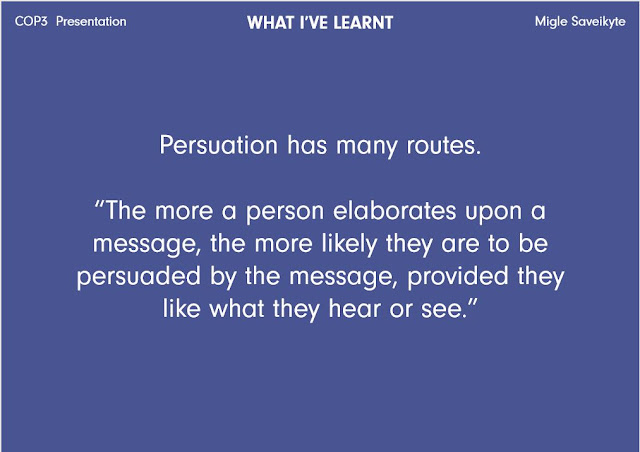Presentation Notes:
1. Research Question: How is graphic design utilised/manipulated?
2. Rationale: Can graphic design make a difference in politics? Can power be designed, are there ways, rules?
3. Theoretical Approaches: Ads affect different people in different ways. There are different approaches in doing this.
4. Theoretical Approaches: Media has a massive impact on politics. Eg General elections - 79% Telegraph readers voted Conservative, 73% Guardian readers voted Labour.
5. What I've Learnt: Social Media. Obamas Hope - first time social media came into play. Trump - all the stuff that mocks him just makes him more powerful.
6. What I've Learnt: Aesthetics. Clinto vs. Trump, Brexit vs. Remain - the unsuccessful campaigns had the nicer and cleaner designs, but they didn't speak as well to their audience, or the 'everyday' person. Trump had baseball caps, Brexit had Wetherspoons mats - things more favoured by their audience.
7. What I've Learnt: Persuation. Central Route makes a person think, has to be relevant to them and makes attitudes ironclad. Eg. Remain and Hillary. Peripheral Route is more default and temporary attitude changes, but just enough to win a vote/election. Uses simple persuation techniques and impressions. Eg. Trump and Brexit.
8. Resources: psychology books, advertising, relevant exhibition book.
9. Practical: unsure which route to take.
- Jeremy Corbyn, Cat Smith - Shadow Minister for Voter Engagement and Youth Affairs, Dawn Butler - Shadow Minister for Women and Equalities.
- Young People - so many did not vote, and those who did voted Labour.
- Campaigns - stop police cuts, safety is desired. Make tower block safe, I like in one. Protect free school meals, they're so expensive, my brother eats £20 per week (He's 11).
Feedback:
- Use social media to encourage voting. eg. stuff that's happening in the USA at the moment.
- Book: Graphic Agitation 1 and 2.
- Maybe your practical could be a false candidate/character that has 'power'.
- Think more closely about what 'role' graphic design plays in politics.
- 'Discourse Analysis' for analysing images/items/campaigns/visuals.
- What is the goal - is it 'power'? money?
- How does a left wing party engage their voters?
At this point I was very confused and completely unsure of what to do, with my essay and my practical. This was because my presentation and the feedback I received was not in my opinion very helpful, I had lost confidence and was not happy with my chosen research question. So I went to have another feedback session, a 1 on 1, to figure out my direction with this module. The feedback I got from that was...
Feedback 2:
- Look at how psychology is used to manipulate consumers within advertising, could help with a direction to take your essay.
- Move away from politics, and focus purely on the design of it.
- Look at how design is used to manipulate, look at emotions? Consumer actions/influence?
- Look at 'Ways of Seeing' by Joh Berger - speaks of visual communication.
- How do we perceive brands/adverts? And in the same way, politicians/campaigns?
- Explore how psychology is utilised to create persuasive advertising?
My second feedback session was far more helpful, because it gave me a clearer understanding of my research topic and really put me on the right direction. I decided to take the advice, and not think about the politics as much as the design of politics, and explore how those political designs affect audiences.
Revised Question:
Exploring how effective is the use of graphic design within political campaigns and protest?














No comments:
Post a Comment